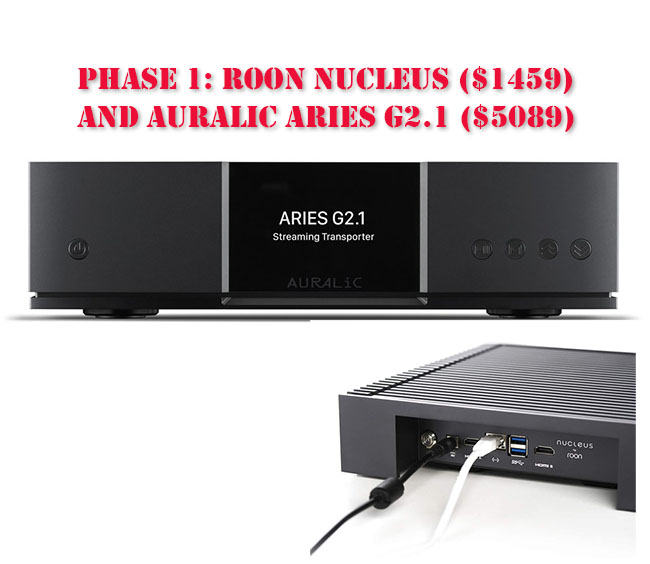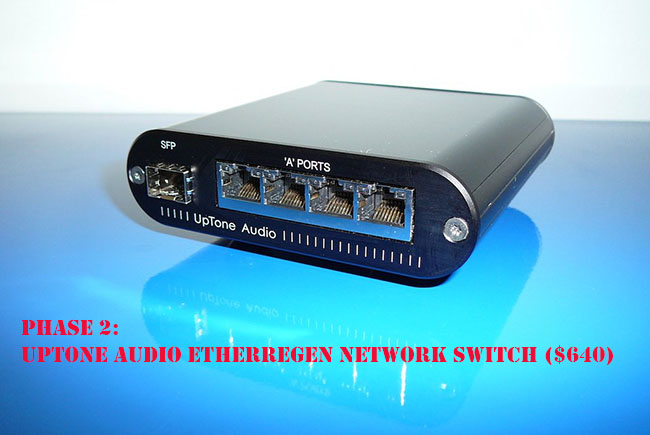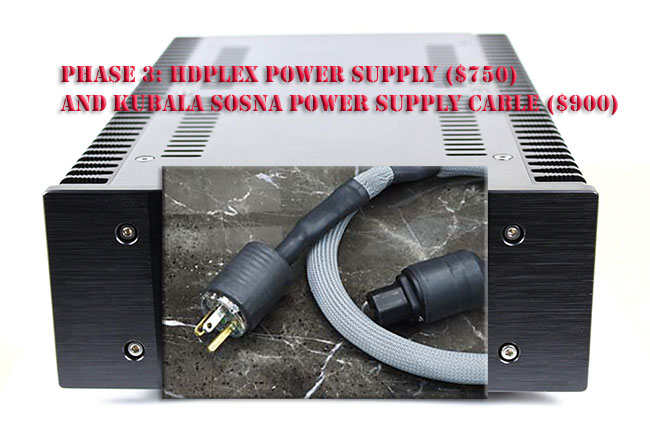NETWORK PROJECT. THE ANATOMY OF A NETWORK SYSTEM by Moreno Mitchelll

 This writing will break down into five Phases of how I built a personal home streaming network. I started as a novice and graduated to a respectable level. It took a great deal of study and research into the audio streaming music technology arena. I will attempt to convey my personal experience and mention many equipment brands that brought me to this point. I am not an expert; however, I stole ideas from many expert published reviews, publications, forums, and white papers. This review prompted me to put together a short informative review for anyone interested in the world of music streaming. One caveat I will mention is that some of the written material terminologies came easy for me to understand due to my Masters in Computer Technology. I will attempt to write this paper and keep it at beginner’s terms.
This writing will break down into five Phases of how I built a personal home streaming network. I started as a novice and graduated to a respectable level. It took a great deal of study and research into the audio streaming music technology arena. I will attempt to convey my personal experience and mention many equipment brands that brought me to this point. I am not an expert; however, I stole ideas from many expert published reviews, publications, forums, and white papers. This review prompted me to put together a short informative review for anyone interested in the world of music streaming. One caveat I will mention is that some of the written material terminologies came easy for me to understand due to my Masters in Computer Technology. I will attempt to write this paper and keep it at beginner’s terms.

Since my introduction to music streaming back in October 2020, I had no interest in the streaming music source mainly because I did not understand the concept of topology related to high-end audio. Over time, I knew that my number one digital source (The LauferTeknik MP64) was due for an upgrade. At present, the MP64 is my primary source of music, especially in the digital arena. I am a big fan of analog; however, my main problem with turntable operation is that I don’t particularly appreciate getting up and flipping the album to side two. Over time, I noticed a plethora of literature and forum talk addressing music streaming technology. Upon studying, I educated myself on the benefits of music streaming, and to my surprise, it was unlimited. Before educating myself, my idea of streaming had been limited to the game and video streamers. I had no idea of the unlimited benefits that musical streaming offered for today’s audiophiles and music lovers. However, over time I became convinced that I wanted to add this technology to my system. The general idea was to purchase a moderately priced streaming setup that fit my budget, to experiment with functions and sonic output to find out what it sounded like in my present system. I was adamant that I was not planning to replace my present Memory Player MP64. I only wanted a second digital source for contingency purposes. Moving forward, I purchased a Roon Nucleus and Auralic Aries G2.1 Wireless Streaming Transporter. I had no experience with either unit; however, I set it up by using the quick setup instructions for both units. I was able to mate the Roon Nucleus and Auralic in minimal time. I then chose Tidal as my streaming music subscriber. What a great choice. Yes, I know some may not agree; however, I felt Tidal offered precisely what I desired for the type of music chosen.
The format I chose to set up Roon and Auralic was wireless. I had no clue or intentions about using a wired connection at the time. One reason for this was that my wireless router was located approximately 50 feet away in another room. Another reason I did not consider a wired connection was for the simple reason that my present wireless streaming setup sounded terrific, and I was fat, dumb, and happy, at least at that time. As audiophiles and music lovers, we always look for the best or most improved way of doing things. We sometimes don’t know how to leave well enough alone. Approximately two months into my streaming venture, I read an article that debated whether to stream using wired versus wireless. The overwhelming consensus pointed favorably towards a wired connection. Arguments for the wired connection made perfect sense to me; however, the one argument that caught my interest was the wired connection coupled with a well-constructed power supply and network switch can significantly eliminate system noise. I needed more information and data to substantiate the latter premise.
Before writing about phase 2, I must briefly mention what led to Phase 2. Stereo Times’ colleague Mike Girardi wrote a fascinating review titled The After Dark Project (see here). Mike Girardi’s study focused on the advanced technology of streaming peripherals and how to get the most out of a wired connection. His review presented me with a new direction and idea. The old; saying, knowledge is power, could not have been further from the truth, especially when I stumbled across an excellent article written by Rajiv Arora entitled “Uptone Audio EtherRegen Review and Comparison.” After reading this article, I must say it assisted me in mapping out a strategy and solidified my understanding of how to construct a viable home network and music streamer. Some of the terminologies are difficult to understand; however, it is well worth the ready (you can find this review on the Uptone Audio website).

Before I get into writing about Phase 2 and the EtherRegen Ethernet Switch, I first need to briefly mention how the Roon Nucleus and Auralic Aires G2.1 combination sounded. I was blown away by the sonics of this combination. I was operating wireless and conducted many sonic comparisons to the LauferTeknik MP64. I was back and forth with my assessments, and most of it depended on the type of music. I gave the MP64 the nod because of its versatility in using the server’s built-in equalizer. However, whenever I programmed a flat response, I must honestly report a toss-up between the two sources. Still, my loyalty lay with the MP64 because it had proved to be my reference for over 12 years, and I was not ready to concede the streamer was the better way to go.
 Enter, the Uptone Audio EtherRegen, Mike Girardi, mentioned this switch to me during a conversation, and I had no idea what he was referring to. He also said he operates his streaming network via a wired connection.
Enter, the Uptone Audio EtherRegen, Mike Girardi, mentioned this switch to me during a conversation, and I had no idea what he was referring to. He also said he operates his streaming network via a wired connection.
I dismissed this because I knew my Roon Nucleus was located near my router, and my Auralic Streamer Transporter was located in another room downstairs. This arrangement had to change. It was not feasible, and I had to make some improvements. = After continued research concerning wired versus wireless, I had to experiment for the sake of curiosity, so I purchased a 100 ft Ethernet cable and routed it from my router in the family room to the Auralic Transporter located downstairs in my listening room. “And the rest is history.” The sonics immediately improved and moved up a level, becoming more transparent and more distinct. The sonic presentation coming from the streamer now rivaled my MP64. Let the games begin.
My next quest was to get my hands on an EtherRegen and later figure out how to build an Ethernet cable path between my internet router and the Auralic. I also remember some of the suggestions and must-haves from the readings in Mr. Rajiv Arora’s review. As I reached out for more information, and was introduced to Mr. Frank Smith of Citronic Music. Mr. Frank Smith was instrumental and is highly knowledgeable in networking and music streaming technology. We spent countless time on the phone and texting, discussing the pros and cons of wireless versus wired. Mr. Frank is very much a proponent of using wired technology. It is highly recommended to contact Frank Smith, especially if you are a novice and want to understand better how to build a pertinent cost-efficient streaming network.


Once I made up my mind to convert strictly to a wired connection, this is when I added the Upton Audio EtherRegen switch, along with an HDPLEX 300W Linear Power Supply (LPS) and a Kubala Sosna Power Cable, it was game over. Before getting ahead of myself, I still had to figure out how to route a 50ft CAT8 Ethernet cable from my network router via the Roon Nucleus and LPS to the EtherRegen connected another LPS. To make a long story short, I designed a path via my utility room for the cable route that worked perfectly, and the cable is not noticeable, thus passing the wife’s approval.
With the addition of the EtherRegen and LPS’s, the sound changed from quiet to almost dead silent. I never thought I would ever bypass my beloved MP64. With the addition of the EtherRegen, thus allowing me to go completely wired, I was amazed at how much the quiet was turned down and how the music flowed effortlessly. I conducted numerous A-B tests between the MP64 and music streamer, and to be perfectly honest; they were still close; however, I had to give the edge to the network streaming topology. At this point, it was a no-brainer; streaming was now my new reference source of digital.
Stereo Times Masthead
Publisher/Founder
Clement Perry
Editor
Dave Thomas
Senior Editors
Frank Alles, Mike Girardi, Russell Lichter, Terry London, Moreno Mitchell, Paul Szabady, Bill Wells, Mike Wright, and Stephen Yan,
Current Contributors
David Abramson, Tim Barrall, Dave Allison, Ron Cook, Lewis Dardick, John Hoffman, Dan Secula, Don Shaulis, Greg Simmons, Eric Teh, Greg Voth, Richard Willie, Ed Van Winkle, Rob Dockery, Richard Doron, and Daveed Turek
Site Management Clement Perry
Ad Designer: Martin Perry








Be the first to comment on: NETWORK PROJECT. THE ANATOMY OF A NETWORK SYSTEM by Moreno Mitchelll